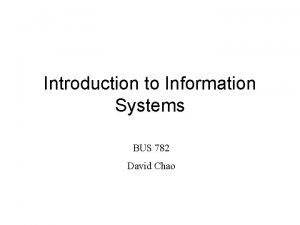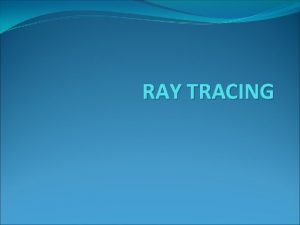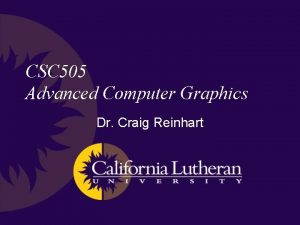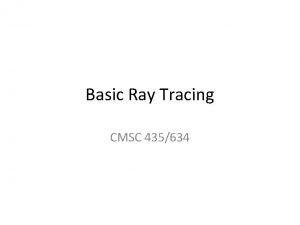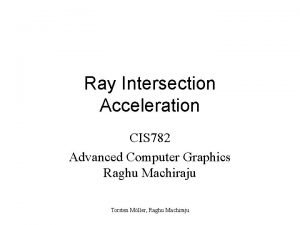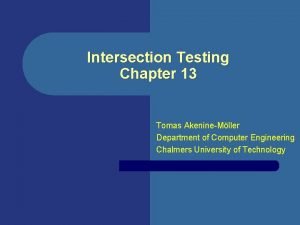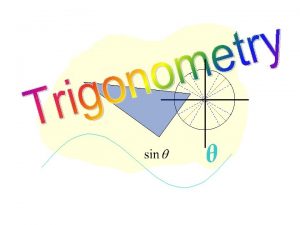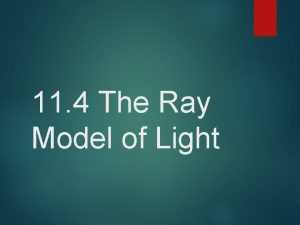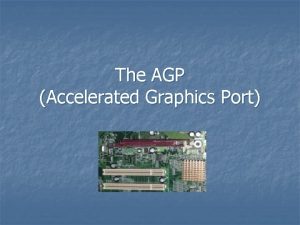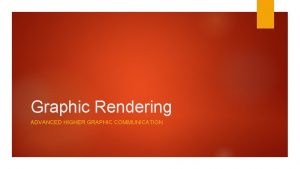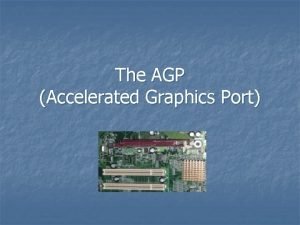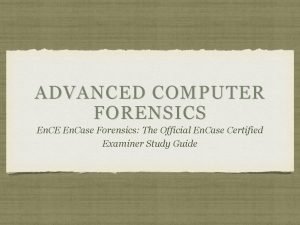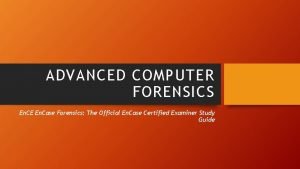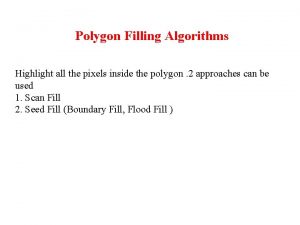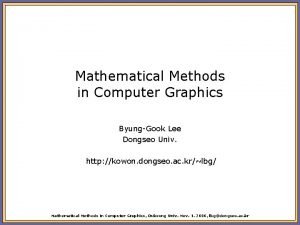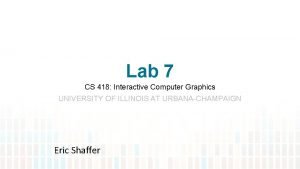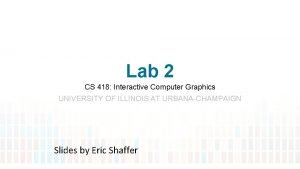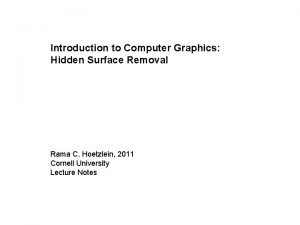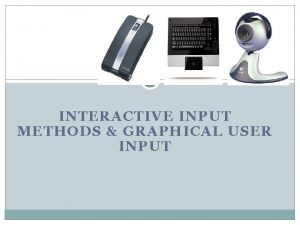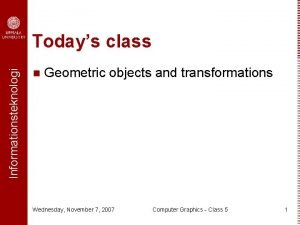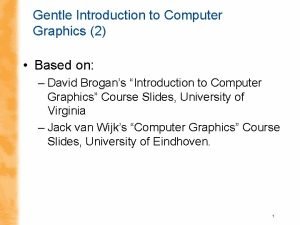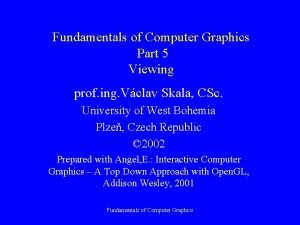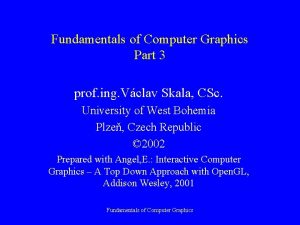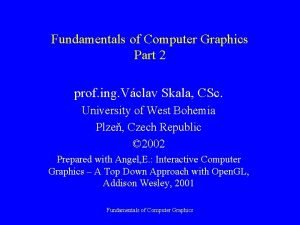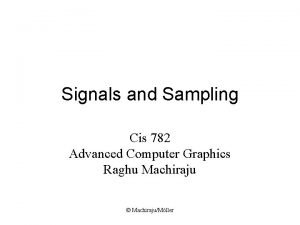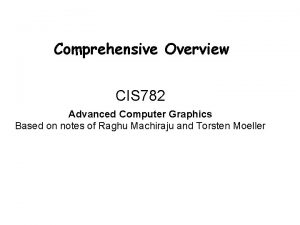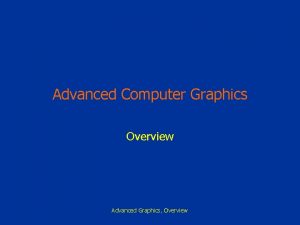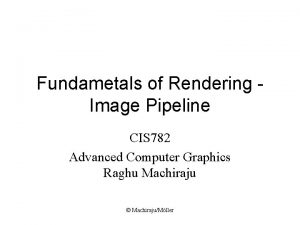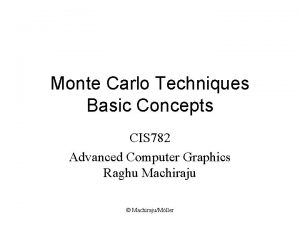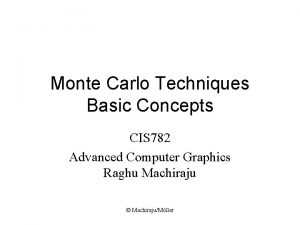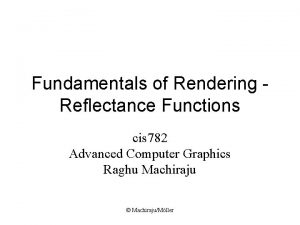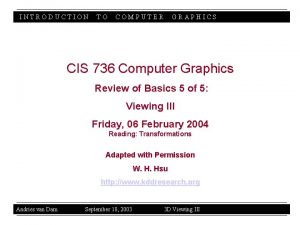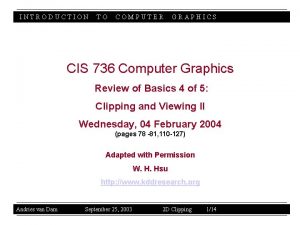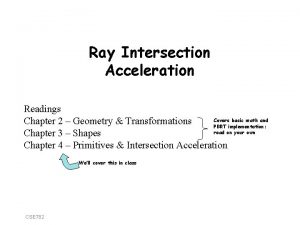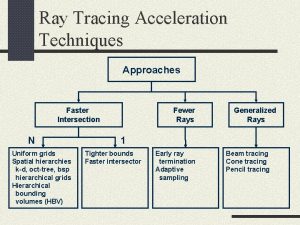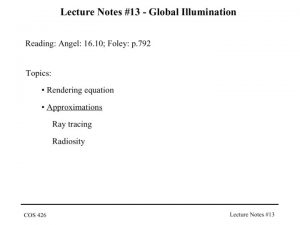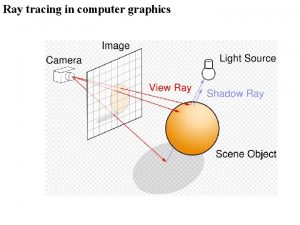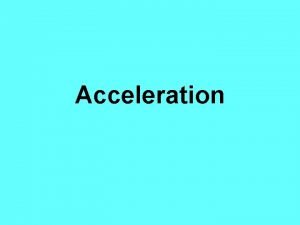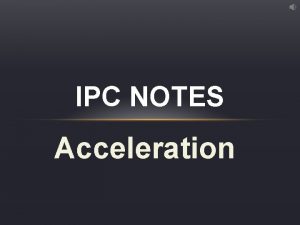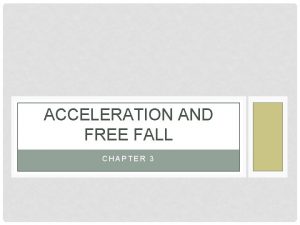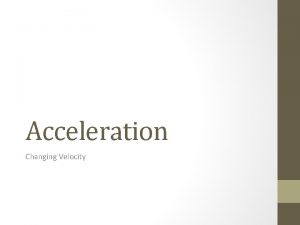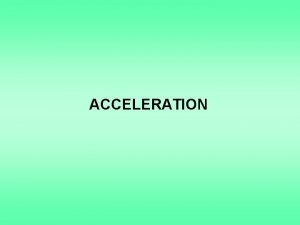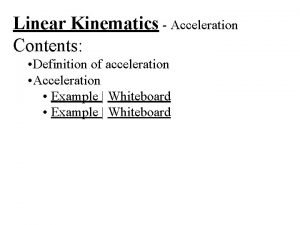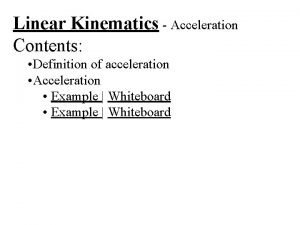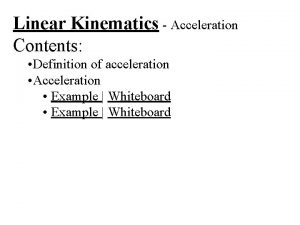Ray Intersection Acceleration CIS 782 Advanced Computer Graphics

































![Amanatides & Woo Algorithm Step[X, Y] +/- 1 • J. Amanatides and A. Woo, Amanatides & Woo Algorithm Step[X, Y] +/- 1 • J. Amanatides and A. Woo,](https://slidetodoc.com/presentation_image/51484b5675a77438d9fe640da712bff0/image-34.jpg)















- Slides: 49

Ray Intersection Acceleration CIS 782 Advanced Computer Graphics Raghu Machiraju Torsten Möller, Raghu Machiraju

Reading • Chapter 2, 3, 4 of “Physically Based Rendering” by Pharr&Humphreys Torsten Möller, Raghu Machiraju

Ray Tracing • Shoot a ray through each pixel; • Find first object intersected by ray Image plane Eye • Compute ray. (More linear algebra. ) • Compute ray-object intersection. • Spawn more rays for reflection and refraction Torsten Möller, Raghu Machiraju

Ray Tracing Architecture LRT Scene Sample Generator Film Parse Rays Lights Eye rays intersect Shadow, reflection, refraction rays Integrator Material Image Camera Radiance Primitives Shape TIFF Torsten Möller, Raghu Machiraju Surf

Optimizing Ray Tracing • Main computation load is ray-object intersection • 50 -90% of run time when profiled • Test for possible intersection before committing to computing intersections Torsten Möller, Raghu Machiraju

Consider this Torsten Möller, Raghu Machiraju

Complexity ! • • I rays or pixels in image N objects O(NI) Can we do O(I log. N) ? Torsten Möller, Raghu Machiraju

Ray Intersection Acceleration Torsten Möller, Raghu Machiraju

Pbrt and Intersections • Primitive base class • Shapes are subclasses of primitive • Aggregate class • Methods – – – World. Bound Can. Intersect. P Refine Primitives Shape Lights • First four return Intersection structures • Last returns Primitives Torsten Möller, Raghu Machiraju Material

Intersection Geometry • Shape independent representation for intersections • Differential. Geometry Intersection: : dg – – Point P Normal N Parametric (u, v) Partial derivatives Tangents: dpdu, dpdv change in normal: dndu, dndv Torsten Möller, Raghu Machiraju

Object-based vs. World-based • Common dichotomy in graphics – objects situated in (world) space – (world) space in which objects reside • Bounding volumes are object-based • Spatial Subdivision is world-based approach • Sub-linear search – logarithmic ? Torsten Möller, Raghu Machiraju

Bounding Volumes Torsten Möller, Raghu Machiraju

Bounding Volumes • • Surround object with a simple volume Test ray against volume first Test object-space or world-space bound? (pros and cons) Cost model - N*cb + pi*N*co – N (number of rays) is given pi – fraction of rays intersecting bounding volume – Minimize cb (cost of intersecting bounding volume) and co (cost of intersecting object) – Reduce ray path – Minimize cost/fit ratio • Bounding sphere – Difficult to compute good one – Easy to test for intersection Reduce ray path • Bounding box – Easy to compute for given object Torsten Möller, Raghu Machiraju – Relatively difficult to intersect (maybe ? ) Arvo&Kirk-Glassner pp. 209

Pbrt’s Bounding Boxes • Virtual BBox Object. Bound() const=0; • Virtual BBox World. Bound() const { return Object. To. World(Object. Bound()); } • Bool BBox: : Intersect. P(Const Ray &ray, Float *hit 0, Float *hitt 1) const { } Torsten Möller, Raghu Machiraju

Bounding Box • Compute min/max for x, y, z • 3 options – Compute in world space • Chance of ill fitting b-box – Compute in object space and transform w/object • Object space b-box probably better fit than world space • Need to intersect ray with arbitrary hexahedral in world sp. – Compute in object space and test in object space • Inverse transform ray into object space Torsten Möller, Raghu Machiraju

Ray & Cube P(t) = s + tc tx 1 = (x 1 - sx)/cx Y = y 2 Z = z 2 X = x 1 tx 2 = (x 2 - sx)/cx Z = z 1 Y = y 1 ty 1 = (y 1 - sx)/cx … Torsten Möller, Raghu Machiraju X = x 2

Square/Cube Note entering and leaving intersections separately Ray is inside after last entering and before first leaving Torsten Möller, Raghu Machiraju

Algorithm set Tnear = - infinity, Tfar = infinity Ray (t) = O + t * Ray For each pair of planes P associated with X, Y, and Z do: (example using X planes) if direction Rayx = 0 then the ray is parallel to the X planes if origin Ox is not between the slabs ( Ox < Xl or Ox > Xh) then return false else if the ray is not parallel to the plane then begin compute the intersection distance of the planes T 1 = (Xl - Ox) / Xd T 2 = (Xh - Ox) / Xd If T 1 > T 2 swap (T 1, T 2) - since T 1 intersection with near plane If T 1 > Tnear =T 1 - want largest Tnear If T 2 < Tfar="T 2" - want smallest Tfar If Tnear > Tfar - box is missed so return false If Tfar < 0 - box is behind ray return false end Möller, If Box survived all above tests, Torsten return true. Raghu with. Machiraju intersection point Tnear and exit point Tfar.

Bounding Sphere • Find min/max points in x, y, z -> 3 pairs • Use maximally separated pair to define initial sphere • For each point – If point is outside of current sphere, increase old sphere to just include new point Torsten Möller, Raghu Machiraju

P R C P rad CP P rad R newrad = (R+rad)/2 newrad P newrad new. C P R C Torsten Möller, Raghu Machiraju new. C = P+(newrad/R)(C-P)

Bounding Slabs • • More complex to compute Better fit of object Use multiple pairs of parallel planes to bound object Can add more slabs to get tighter fit © 2004 Pharr, Humphreys Torsten Möller, Raghu Machiraju

Approximate Convex Hull • Find highest vertex • Find plane through vertex parallel to ground plane • Find second vertex that makes minimum angle with first vertex and up vector • Find third vertex that makes plane whose normal makes minimum angle with up vector Slabs - More effort to compute, better fit Torsten Möller, Raghu Machiraju

Hierarchical Bounding Volumes • Compute bounding volume for groups of objects Torsten Möller, Raghu Machiraju

Hierarchical Bounding Volumes • Create tree of bounding volumes • Children are contained within parent • Creation preprocess – From model hierarchy – Automatic clustering • Search intersect(node, ray, hits) { if( intersectp(node->bound, ray) if( leaf(node) ) intersect(nodeprims, ray, hits) else for each child intersect(child, ray, hits) } Torsten Möller, Raghu Machiraju Return the closest of all hits !

Problem • Subtrees overlap • Does not contain all objects it overlaps • Balance Tree Organization Torsten Möller, Raghu Machiraju

Spatial Enumeration • Divide space into ‘voxels’ • Bucket sort objects in voxels they intersect – Object goes into each voxel it touches – Reuse results from one voxel calculation • Determine voxels that a ray intersects – Only deal with the objects in those voxels Torsten Möller, Raghu Machiraju

Spatial Enumeration • Identifying voxels hit is like a line drawing algorithm Torsten Möller, Raghu Machiraju

Uniform Grids • Preprocess scene • Find Big bounding box Torsten Möller, Raghu Machiraju

Uniform Grids • Preprocess scene • Find Big bounding box • Determine grid resolution (how ? ) Torsten Möller, Raghu Machiraju

Uniform Grids • Preprocess scene • Find bounding box • Determine grid resolution • Place object in cell if its bounding box overlaps the cell Torsten Möller, Raghu Machiraju

Uniform Grids • Preprocess scene • Find Big bounding box • Determine grid resolution • Place object in cell if its bounding box overlaps the cell • Check that object overlaps cell (expensive!) Torsten Möller, Raghu Machiraju

Add Sorting • If objects/voxels/cells are processed in front -to-back sorted order, stop processing when first intersection is detected • e. g. , process cells in bottom to top, left to right order and stop at first intersection Torsten Möller, Raghu Machiraju

Uniform Grids • Preprocess scene • Traverse grid – 3 D line = 3 D-DDA – 6 -connected line • pbrt algorithm (grid accelarator) Torsten Möller, Raghu Machiraju
![Amanatides Woo Algorithm StepX Y 1 J Amanatides and A Woo Amanatides & Woo Algorithm Step[X, Y] +/- 1 • J. Amanatides and A. Woo,](https://slidetodoc.com/presentation_image/51484b5675a77438d9fe640da712bff0/image-34.jpg)
Amanatides & Woo Algorithm Step[X, Y] +/- 1 • J. Amanatides and A. Woo, "A Fast Voxel Traversal Algorithm for Ray Tracing", Proc. Eurographics '87, Amsterdam, The Netherlands, August 1987, pp 1 -10. t. Max[X, Y] – first intersection t. Delta[X, Y] - voxel distance in [X, Y] Torsten Möller, Raghu Machiraju

A&W Algorithm Torsten Möller, Raghu Machiraju

A&W Algorithm Results • Rendering time for different levels of subdivision Torsten Möller, Raghu Machiraju

Objects Across Multiple Voxels • • • Mailboxes eliminate redundant intersection tests Objects have mailboxes Assign rays numbers check against objects last tested ray number Intersection must be within current voxel Torsten Möller, Raghu Machiraju

Hierarchical Spatial Subdivision • • • Recursive subdivision of space 1 -1 Relationship between scene points and leaf nodes Example: point location by recursive search(log time) Solves the lack-of-adaptability problem DDA works Effective in practice Torsten Möller, Raghu Machiraju

Variations KD tree octtree Torsten Möller, Raghu Machiraju BSP tree

Example A D B B C C D A Leaves are unique regions in space Recursive search Torsten Möller, Raghu Machiraju Kd. Tree. Accel - pbrt

Creating Spatial Hierarchies insert(node, prim) { if( overlap(node->bound, prim) ) if( leaf(node) ) { if( node->nprims > MAXPRIMS && node->depth < MAXDEPTH ) { subdivide(node); foreach child in node insert(child, prim) } else list_insert(node->prims, prim); } else foreach child in node insert(child, prim) } // Typically MAXDEPTH=16, MAXPRIMS=2 -8 Torsten Möller, Raghu Machiraju

Comparison Scheme Uniform grid D=1 Spheres Rings Tree 244 129 1517 83 781 116 34 D=20 38 Hierarchical grid • 34 See “A Proposal for Standard Graphics Environments”, IEEE Computer Graphics and Applications, vol. 7, no. 11, November 1987, pp. 3 -5 Torsten Möller, Raghu Machiraju

Questions? • Some complexity numbers – Triangle – Sphere • • • Scenes to render? “Teapot in a stadium” versus uniform distribution Multiplicative constants important Adaptability allows robustness Cache effects are important See http: //sgi. felk. cvut. cz/BES/ Best Efficiency Scheme Project Torsten Möller, Raghu Machiraju

Figure 7 Torsten Möller, Raghu Machiraju

Figure 9 Torsten Möller, Raghu Machiraju

L, G for Ellipsoids Torsten Möller, Raghu Machiraju

Ellipsoid Blend Torsten Möller, Raghu Machiraju

Ellipsoid Blend Torsten Möller, Raghu Machiraju

What is next? Torsten Möller, Raghu Machiraju
 782 bus
782 bus 782 bus
782 bus Ray casting algorithm
Ray casting algorithm Cathode ray tube in computer graphics
Cathode ray tube in computer graphics Advanced computer graphics
Advanced computer graphics Graphics monitors in computer graphics
Graphics monitors in computer graphics Lcd working principle ppt
Lcd working principle ppt 435634
435634 The intersection of three planes can be a ray.
The intersection of three planes can be a ray. Ray box intersection
Ray box intersection Ray box intersection
Ray box intersection Solar eclipse accel
Solar eclipse accel Linear acceleration and angular acceleration
Linear acceleration and angular acceleration Radial acceleration definition
Radial acceleration definition Linear acceleration vs tangential acceleration
Linear acceleration vs tangential acceleration Tangential acceleration and centripetal acceleration
Tangential acceleration and centripetal acceleration Terminal ray
Terminal ray Ray model of light
Ray model of light Accelerated graphics port year created
Accelerated graphics port year created Higher graphic communication
Higher graphic communication Accelerated graphics port speed
Accelerated graphics port speed Computer architecture
Computer architecture Advanced topics in computer science
Advanced topics in computer science Advanced computer forensics
Advanced computer forensics Fastbloc
Fastbloc Angel computer graphics
Angel computer graphics Types of projection in computer graphics
Types of projection in computer graphics Display devices in computer graphics
Display devices in computer graphics Exterior clipping
Exterior clipping Shear transformation in computer graphics
Shear transformation in computer graphics Shader computer graphics
Shader computer graphics Scan conversion in computer graphics
Scan conversion in computer graphics Equation of motion of a rotating rigid body
Equation of motion of a rotating rigid body The region of
The region of Advantages and disadvantages of scan line fill algorithm
Advantages and disadvantages of scan line fill algorithm Fill polygon algorithm
Fill polygon algorithm Raster scan and random scan
Raster scan and random scan Computer graphics
Computer graphics Computer graphics line drawing algorithm
Computer graphics line drawing algorithm Cs 418 interactive computer graphics
Cs 418 interactive computer graphics Glcreatebuffer
Glcreatebuffer Hidden surface removal algorithm in computer graphics
Hidden surface removal algorithm in computer graphics Achromatic light in computer graphics
Achromatic light in computer graphics What are the interactive input methods? explain in detail
What are the interactive input methods? explain in detail Uniform scaling in computer graphics
Uniform scaling in computer graphics Uniform scaling in computer graphics
Uniform scaling in computer graphics Fundamentals of computer graphics
Fundamentals of computer graphics Logical input devices in computer graphics
Logical input devices in computer graphics Fundamentals of computer graphics
Fundamentals of computer graphics Points and lines in computer graphics ppt
Points and lines in computer graphics ppt
